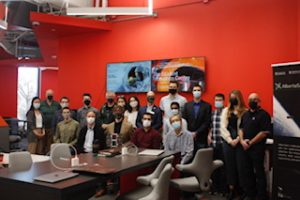Test Readiness Review

By Emily Seto, Priya Grewal, Lauren Dara, Nikhil Velagapudi
On November 30, 2021, AlbertaSat had the Test Readiness Review (TRR). The TRR is a presentation given by AlbertaSat to select members of the Canadian Space Agency (CSA) and Nanoracks. Members that attended from the CSA include Tony Pellerin, Alfred Ng, Jean-François Cusson, and Francis Martin. Members from Nanoracks attended virtually. The TRR acts as a follow-up to the Critical Design Review (CDR) which took place in early 2020. The purpose of the presentation is to deliver updates on our flight plans, subsystems, and any other progress made since the CDR as well as to receive feedback from the advisors from the CSA and Nanoracks. After the presentations a tour of the AlbertaSat labs were given to the in-person attendees.

Team leads from each subsystem presented their major announcements, current progress as well as any needed risk analysis. The following represents some highlights from each team’s presentation. From Project Management we learnt that the core engineering FlatSat is complete and our Educational Outreach team is flourishing. Systems Engineering announced that the thermal vacuum is nearly complete and that the cleanroom is complete with the solar panels having been successfully tested in it. The Mechanical team completed initial vibration testing and is currently performing deployable testing with the solar panels successfully deployed in demonstration. An exciting announcement from the Communications team revealed that binary testing is complete on the engineering model and the flight model of the communications board is ready to be constructed. The ADCS team successfully unpacked and completed unit testing on the 3-axis and y-momentum ADCS units with binary testing well underway. The Mission Design team solidified the launch and early operations plan and also spoke about the new S-Band ground station being hosted at a NARC facility west of Edmonton. From the Power team we learnt that the solar array has been tested with other satellite components and gives nominal results with the flight model EPS and solar panels completely done and ready to go. These were assembled in the new cleanroom. The on-board computer boards have undergone complete testing and the potential flight models are currently underway. One of the prototypes has been implemented into the FlatSat and testing with the other components has provided successful results. The Payload of Ex-Alta 2 (Iris) has had major advances in prototyping and testing. Regarding the Northern Spirit Initiative, the Aurora Research Institute and Yukon University’s payload for their respective 2U CubeSat has engineering models at the University of Alberta that will be tested with respect to other components on the satellite. Both institutions have collaborated in the manufacturing of their payloads and have saved thousands of dollars in this way. Overall each of the subsystems and teams had very successful presentations with the respective team leads able to answer questions and pose questions to the officials from the CSA and Nanoracks.

Following each subsystem presentation was a question period where the academic advisors and the representatives from the CSA and Nanoracks could ask questions regarding the current progress of the team. The feedback from each question period allowed all teams to address or make any necessary changes to their plans.
Ex-Alta 2 will be launched alongside YukonSat and AuroraSat as part of the Northern Spirit initiative and is expected to launch in December 2022. As the launch date approaches, AlbertaSat will continue to prepare for the mid-way TRR which takes place in early 2022, as well as the final TRR that will take place in April 2022.
